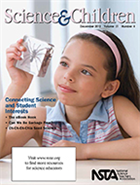Cooking as science
By Peggy Ashbrook
Posted on 2013-12-31
 On the winter solstice I took a walk through the yard and thought about the amount of sunlight that it receives throughout the year. Much less these days as the silver maple has grown many feet since the year my son made and tested a solar cooker as his science class project. After he was finished with the cooker I used it for a few years to make one-pot chicken and rice dishes. Read about other young children’s solar cooking exploration in the Council for Elementary Science International’s July 2012 newsletter (page 6).
On the winter solstice I took a walk through the yard and thought about the amount of sunlight that it receives throughout the year. Much less these days as the silver maple has grown many feet since the year my son made and tested a solar cooker as his science class project. After he was finished with the cooker I used it for a few years to make one-pot chicken and rice dishes. Read about other young children’s solar cooking exploration in the Council for Elementary Science International’s July 2012 newsletter (page 6).
 In the Early Years column in the December 2013 issue of Science and Children, I wrote about science concepts involved in cooking with young children. The children made ice cream following a recipe; touching, describing and classifying the ingredients; making measurements; and using their sense of touch to observe changes in temperature and consistency. The colder temperatures of winter make us think of warm drinks inside and frozen water outside. Explorations into changes in temperature can include “cooking” ice cream using common kitchen supplies–plastic bags, tape, salt, ice, cream and flavoring. Pair this activity using our sense of touch to observe changes in temperature with an outdoor activity such as putting cups of water in a place where they won’t be disturbed as freezing temperatures solidify the water into ice. Children also enjoy sliding ice cubes down ramps. They experience melting if they hold the ice cubes in warm hands or in warm weather.
In the Early Years column in the December 2013 issue of Science and Children, I wrote about science concepts involved in cooking with young children. The children made ice cream following a recipe; touching, describing and classifying the ingredients; making measurements; and using their sense of touch to observe changes in temperature and consistency. The colder temperatures of winter make us think of warm drinks inside and frozen water outside. Explorations into changes in temperature can include “cooking” ice cream using common kitchen supplies–plastic bags, tape, salt, ice, cream and flavoring. Pair this activity using our sense of touch to observe changes in temperature with an outdoor activity such as putting cups of water in a place where they won’t be disturbed as freezing temperatures solidify the water into ice. Children also enjoy sliding ice cubes down ramps. They experience melting if they hold the ice cubes in warm hands or in warm weather.Maureen’s blog, “Pondering Preschool” tells how her class of three-year-olds used early literacy skills and design skills as they developed imaginative play extensions of a nutrition and cooking project. They also used engineering practices as they designed and built devices to get a great big turnip out of the ground, inspired by a version of the traditional tale first recorded by Alexei Tolstoy. (Listen to a second grade class tell the story here. They were inspired by Heather Forest’s telling of the tale.)
Safety precautions are also part of cooking—the safe smelling “wafting” technique of waving the smell of a substance towards you rather than sticking your nose into it, washing hands and tasting only in cooking, not science. Creativity and science come together in growing food, harvesting and preparing it. Do you have a cooking story to tell?
Disclaimer: The views expressed in this blog post are those of the author(s) and do not necessarily reflect the official position of the National Science Teaching Association (NSTA).




